“I think 2020 might be the peak email newsletter year,” he said.
That's Emanuel Cinca, founder of Stacked Marketer; a 6-figure daily email newsletter with over 16,000 subscribers.
Emanuel noticed the email newsletter trend in around 2019 and has experienced explosive growth in the 2 years since he founded Stacked Marketer.
I sat down with him to distill his lessons into actionable takeaways that are applicable to anyone thinking of starting and monetizing an email newsletter. Here’s what you can learn:
%(tableofcontents)
Free Newsletter that Generates 6-Figure in Revenue
Stacked Marketer curates digital marketing news, tech and actionable advice in a daily newsletter which can be consumed in 5 minutes or less.
In under 2 years, Stacked Marketer has grown to over 16,000 subscribers and is projected to generate over $200,000 in revenue by the end of 2020.
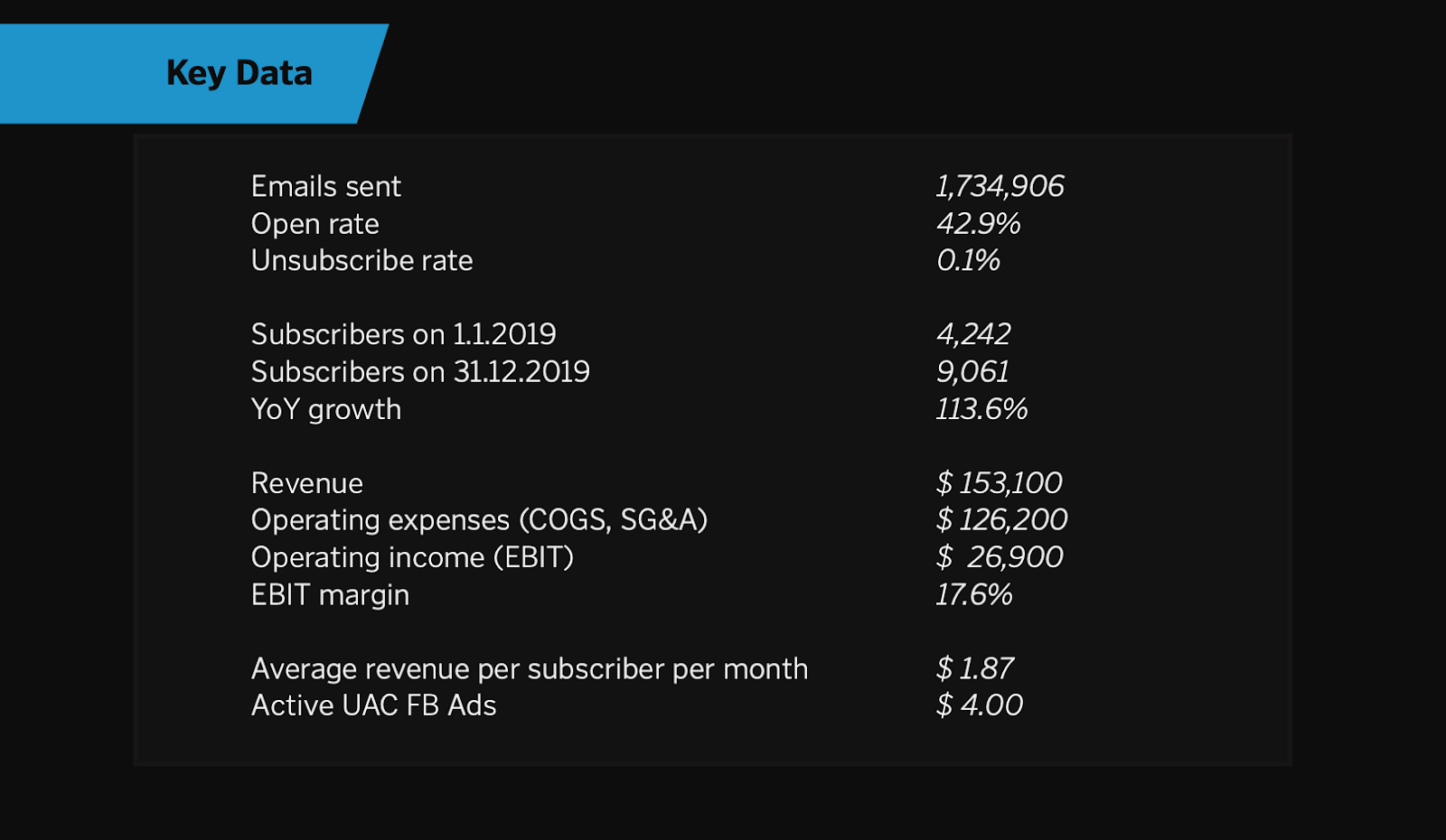
Just look at this upward trajectory of growth in subscribers:
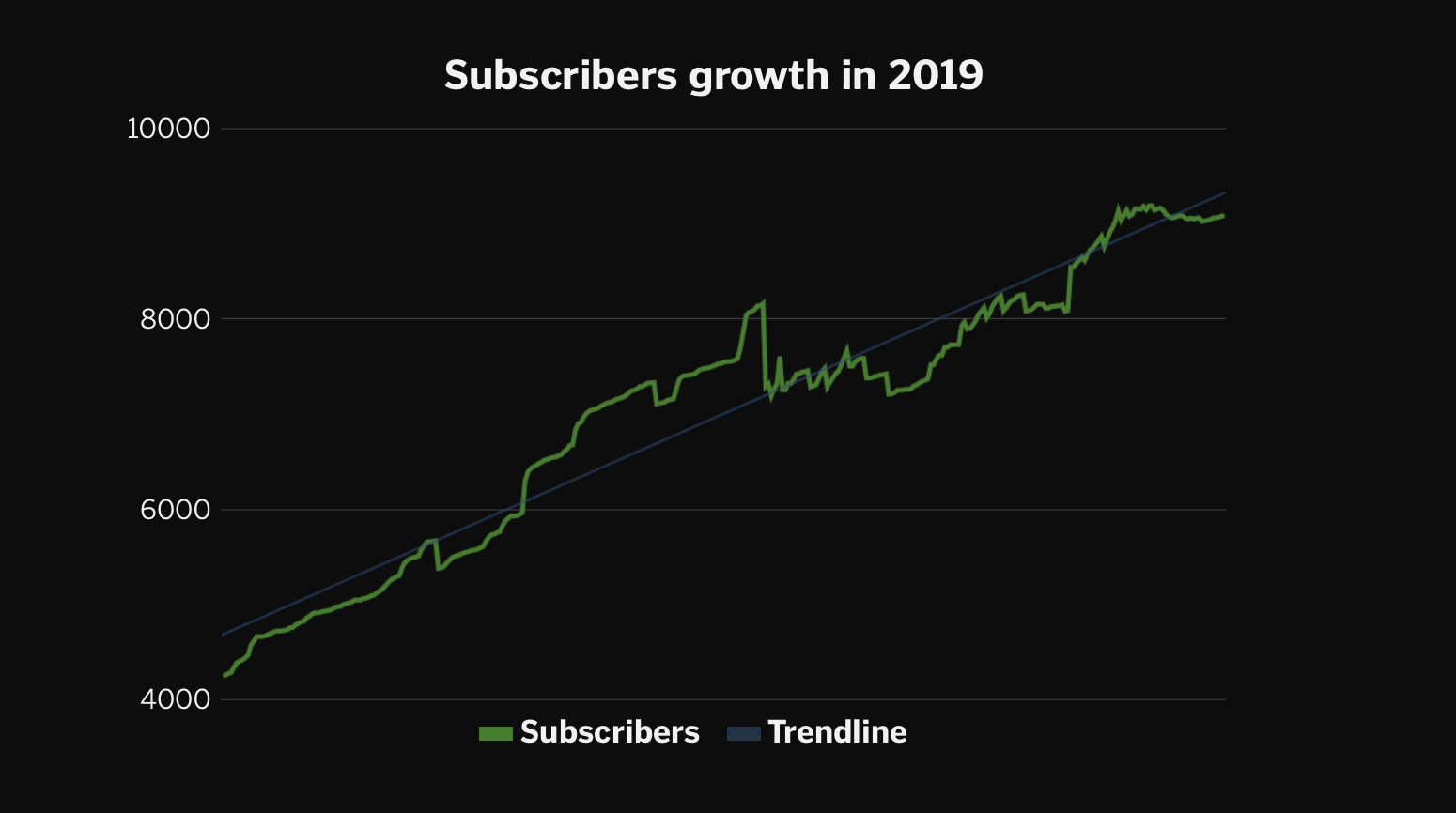
While the current hype is around premium (paid) newsletters, Stacked Marketer took the old school approach to monetization through ad placements & sponsorships.
Aside from those two monetization strategies, there are plenty of other strategies that you can use to monetize your newsletter, which we’ll get into later.
Before we get into the nitty-gritty, let’s see why email is still a superior channel.
Why Use Email and Not Another Channel?
“Email is a great channel to deliver something useful,” says Emanuel.
Everyone says they hate email. But for all the animosity and the number of companies that have set out to assassinate email (think Slack, Asana, Facebook Messenger), it’s thriving and spawning a whole new, democratized style of publishing.
Email is the gentle, dependable workhorse that everyone relies on. And it’s a channel that still works extremely well.
There’s a reason that large publishers like Quartz and Vox are moving into the space and emphasizing email newsletters as a way to reach readers.[*]

But what I find fascinating is that it provides a democratized platform for the smaller fish.
Here’s what some of the smaller creators who run successful newsletters have to say about email's superiority as a channel.
1. Eddie Shlyner from Very Good Copy (ex Head Copywriter @ G2)
“You just get a lot of bang for your buck. Every email campaign is measurable, targeted, and if you’re building an ethical list, welcome. And the ROI is remarkable. Something like every $1 spent on email marketing gets a $38 return. Nice. Bottom line, email is an incredibly intimate, flexible channel that doesn’t cost a lot to use. If you know copywriting, you’ll likely find success.”
2. Justin Blackman from Pretty Fly Copywriting:
“Email is the only platform that lets you speak to your *entire* audience in a personal, genuine, uncensored manner—where you can TRULY be yourself—without having to finagle some wonky algorithm and pray that people see it. There’s nothing more personal than an inbox.”
3. Dave Harland from The Word Man (copywriter for Nespresso, Land Rover & other Fortune 500 companies):
“Email is a superior channel because people have signed up for it, so you have more of their attention from the outset, rather than just shouting something out loud and hoping someone will listen, like most other forms of marketing.”
In an increasingly noisy world, email provides a channel to reach readers 1-on-1 and deliver something useful in a truly meaningful way.
The small team at Stacked Marketer experimented with a Youtube channel and a podcast but quickly found that they require a different set of skills and a significant effort to grow.
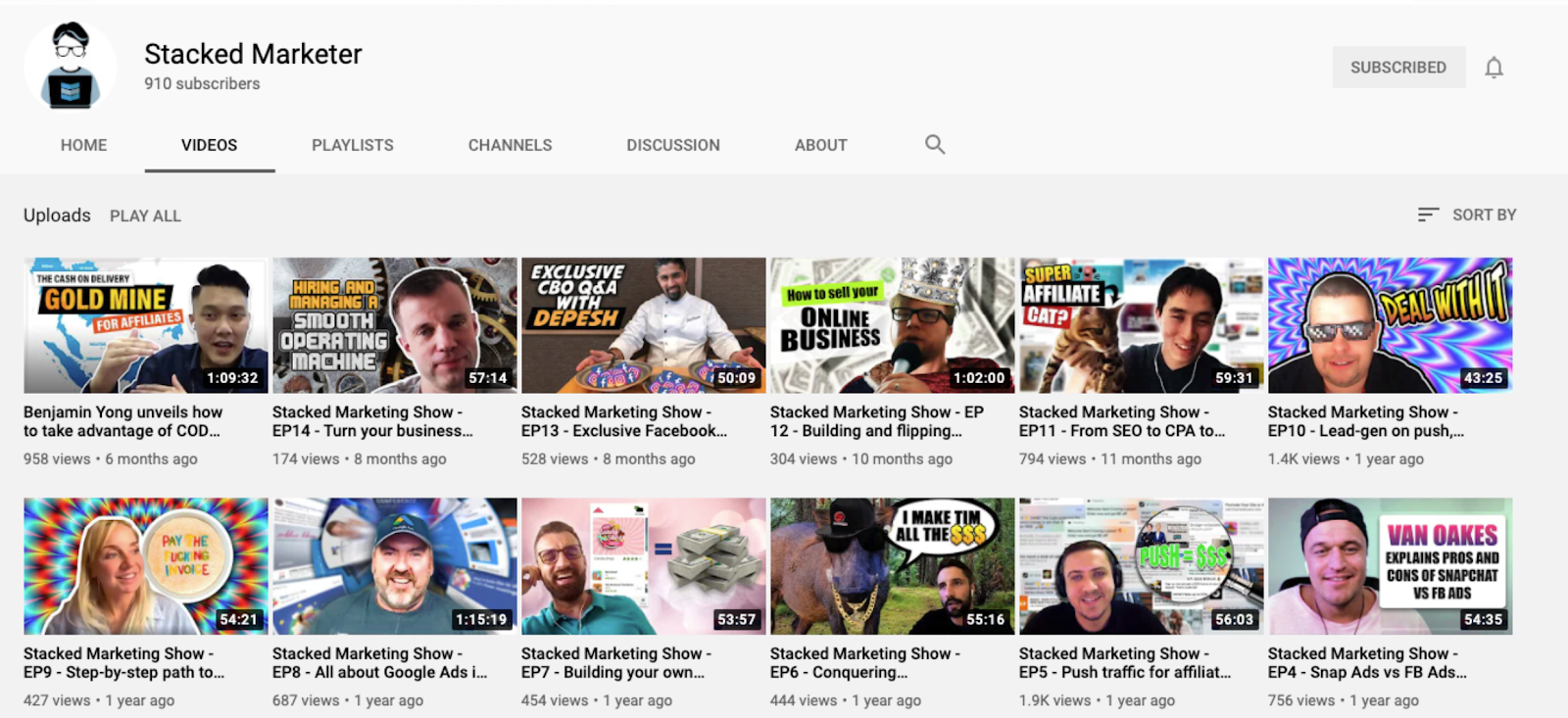
Plus, they wanted to have a direct connection with their audience as much as possible, says Emanuel.
As Emanuel pointed out, the email newsletter wave has been swelling for some time now and it’s reaching its peak.
Obviously, you’re reading this so you can learn how to ride the crest of that high and beautiful wave before it crashes and rolls back and all you’re left with is a regretful view of the high water mark.
Aloha. Let’s learn how to ride that wave.
How to Create a Newsletter
With the plethora of tools at your disposal today, the technical aspect of creating a newsletter is pretty straightforward (we’ll get into that in the next section).
This section is about taking a step back to think about the substance of your newsletter.
In other words, what will you be writing about and how can you provide value or offer a unique angle in your industry?
Finding Your Niche
In 2018, Emanuel started building email lists for different niche audiences. Nothing was catching on but he realized something crucial:
He was trying to build a product in an industry he didn’t know.
So he took a step back and started thinking about how he could add value in an industry he knew well; marketing.
I’ve written about this time and time again and had to go through my own niche selection process throughout my career as a content marketer.
So many people get stuck in the niche selection phase because they overcomplicate it.
Your niche lies at the intersection between your interests, knowledge and experience. Here’s how you can identify this intersection with a stupid-simple exercise:
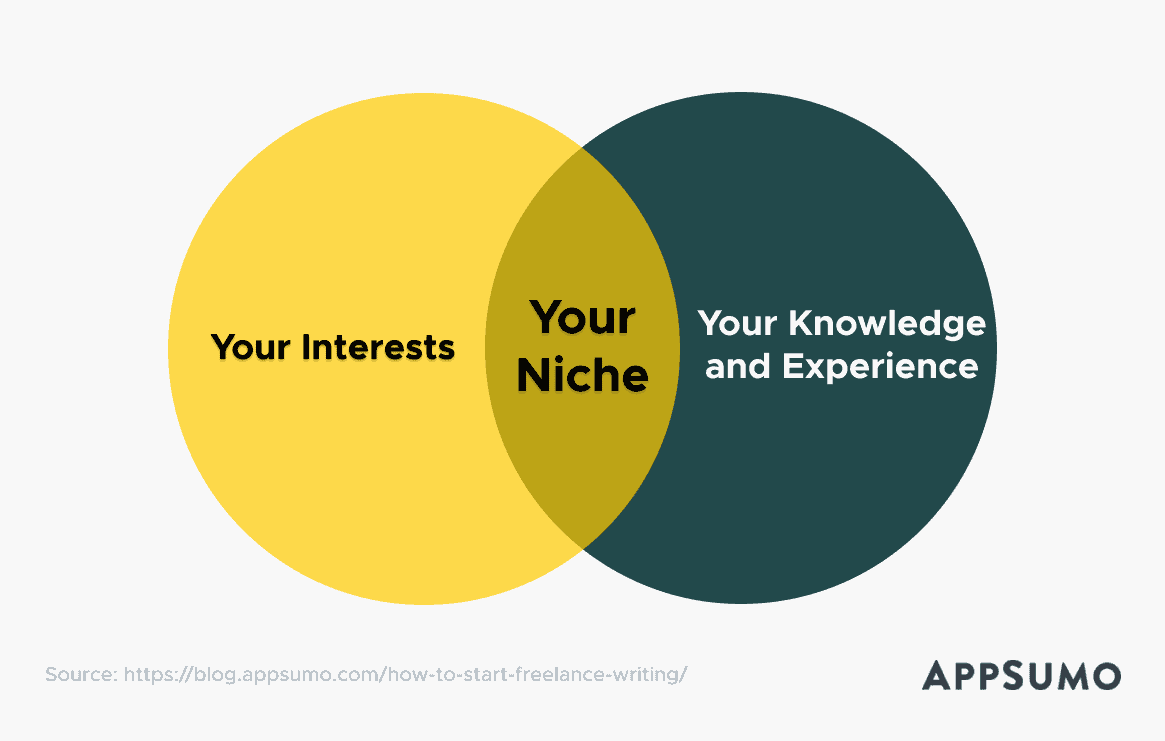
Once you’ve identified your niche, you can start working on refining your unique value proposition.
Clarifying Your Unique Value Proposition (UVP)
Providing unique value is something that all successful businesses have to figure out. This is true for businesses selling physical products, software, and a newsletter (even if you aren’t expecting people to pay for it)!
What unique value, angle or perspective can you provide?
I’ll make this easier for you by breaking it down into 3 “value-providing buckets:”
- Convenience. A curated newsletter helps people save time.
- Entertainment. An entertaining newsletter helps people with…well, pure entertainment.
- Actionable knowledge. An analytical or business newsletter helps people make better business decisions (and more money).
Now, you don’t have to pigeonhole yourself into any of these buckets. But if you define your value proposition clearly within the confines of these three buckets, you’ll have a higher chance of resonating with a specific audience. Obviously, you can (and probably should) provide an element from all three buckets.
Notice how Stacked Marketer have done precisely that with their UVP:
Carefully curated digital marketing news, trends, ad tech and actionable advice delivered every weekday to your inbox with a sprinkle of humour.
Let’s break that down:
- Carefully curated digital marketing news = convenience.
- Ad tech and actionable advice = actionable knowledge.
- A sprinkle of humour = entertainment.
Providing Value
Remember, if you plan on monetizing your newsletter (which you probably are since you’re reading this), you need to truly provide value.
Focus on one of the three value-providing buckets to begin with and start sprinkling on top using elements from the other buckets once you’ve found your mojo.
Technical Stuff: Creating a Newsletter
As I mentioned earlier, the technical part of creating a newsletter is easy. The only ounce of wisdom that I can impart here is that you need to think ahead when choosing your newsletter service.
Choosing a Newsletter Service Provider
Before you jump in with any particular provider, spend some time anticipating how you intend to monetize your newsletter and what kind of benefits you might offer your subscribers.
Planning ahead here is crucial because if your provider doesn’t have the functionality or services you need, it’ll take substantial work to develop it or you’ll have a glued-together system that increases your workload.
You don’t want a part of you to regret not using a full-service paid newsletter platform or a subscription management service after you’ve done the hard work of building an audience.
So which provider should you go for?
If you want to start a subscription-based paid newsletter, Memberful provides a subscription management service with neat features like member-only podcasts, subscriber comment sections and automatic archives.
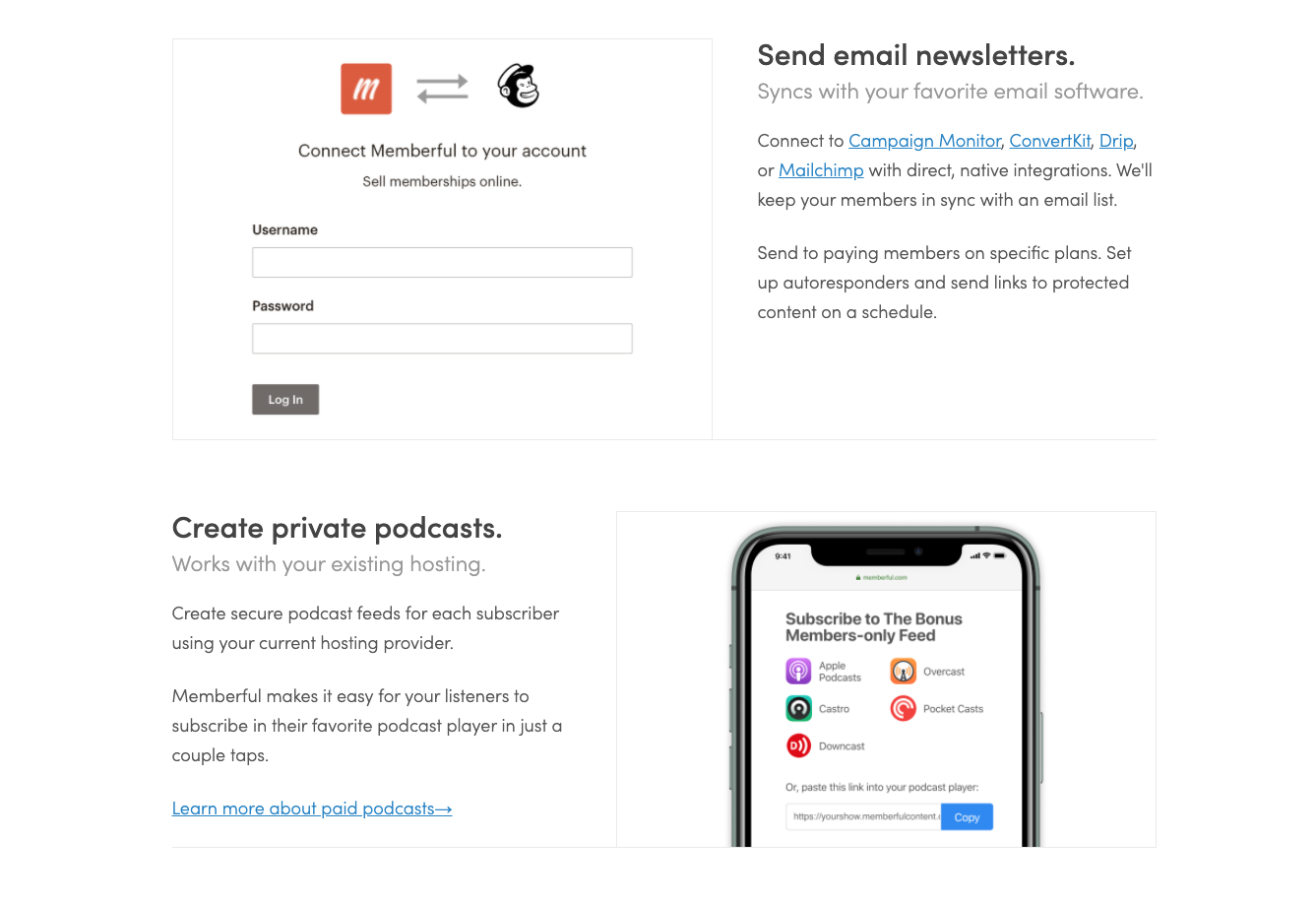
If you’re planning on starting a free newsletter and monetizing it with different strategies, SendFox provides a simple solution with neat automations and a user-friendly interface.

Stacked Marketer use Campaign Monitor, which they switched to from Active Campaign because it didn’t provide granular user permissions and good templating language.
If you have no idea what functionality you’ll need, here are some things you may need that go beyond the basic infrastructure of actually getting your newsletter content sent to your subscribers.
Beyond the Basics
Here’s some functionality that you might want to add:
- A custom domain
- A custom branded website
- Member-protected content
- Member management dashboard
- Integrations with third-party tools
- Content embeds for video and audio
Getting a Custom Domain and Building a Branded Website
People often get stuck or delay launching their email newsletter because they think they need a fancy website.
Here’s what Emanuel has to say about that (I couldn’t agree more):
“You definitely don’t need a fancy website. When it comes to newsletters specifically, all you need to start is a landing page where people can submit their email. On that page, you should have 3-4 lines explaining what your newsletter does and you’re more than good to go.”
All you need is a field to capture people's email address and a reason for them to give you their email address. The reason is your UVP, which we discussed earlier. And you can easily set up an email capturing field with the landing page feature in SendFox.
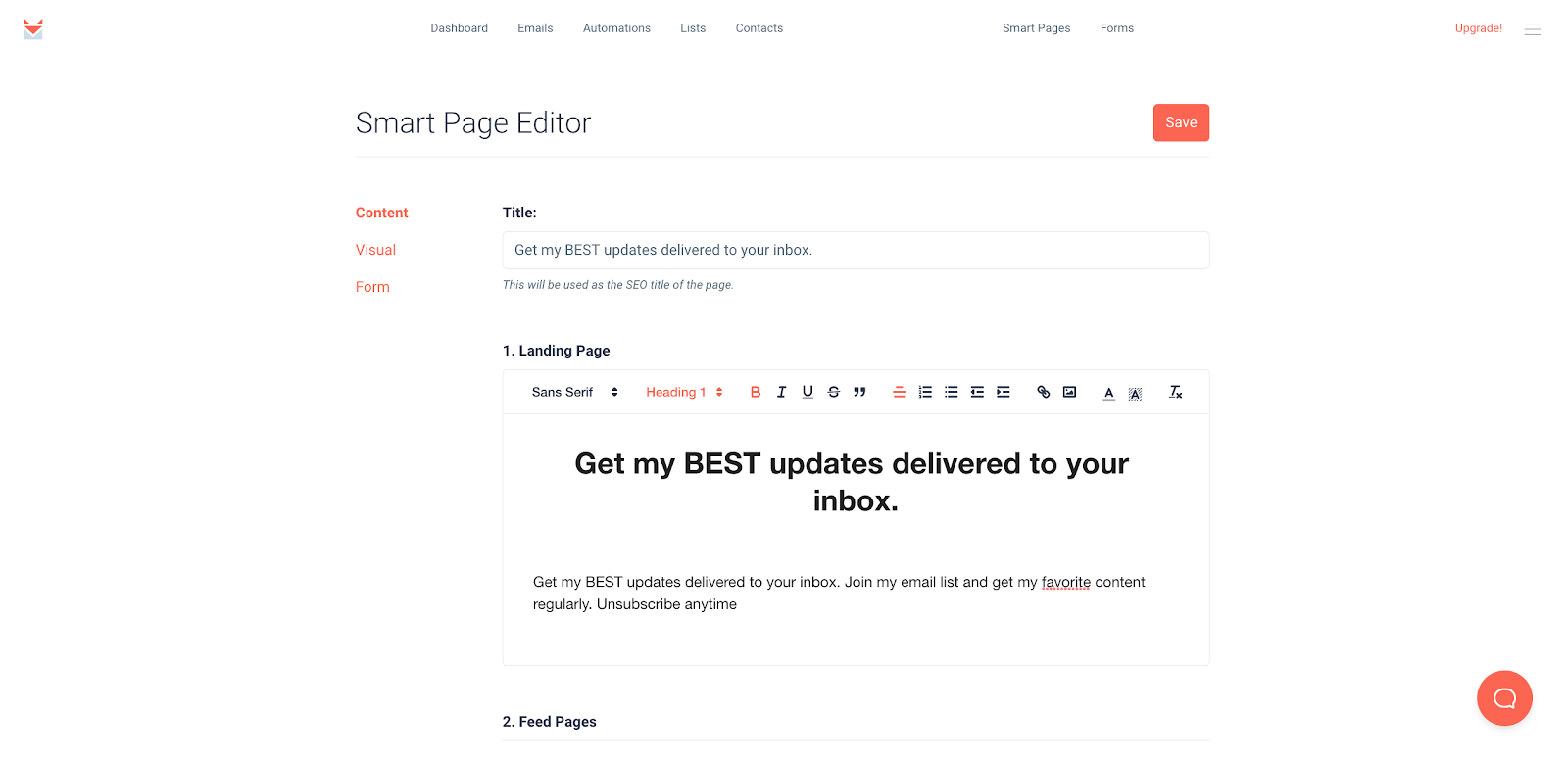
As Emanuel mentions, condense your UVP into 3-4 lines or a single sentence if possible.
Running Costs
The hard, recurring costs of running a newsletter are primarily the email provider you use, web hosting, domains and email and other software.
Stacked Marketer spend $800 per month for their tech stack.
“If you’re a one-person newsletter, you can cut costs significantly. Running costs will purely depend on how much your tool of choice costs for the number of subscribers you have,” says Emanuel.
Attracting Your First 100 Subscribers
The hardest part about starting a business is getting started in the first place. The second hardest part is getting your first customer, and your first 100 customers and beyond.
Within a day of launching, Stacked Marketer had their first 100 subscribers and 1,000 subscribers within their first month. Before that discourages you, I’ll drop this quote of encouragement from Emanuel to give you perspective:
“I was probably right on the edge of knowing enough people to try this thing out…”
And here’s exactly what Emanuel did to get there:
“At the very beginning, shoutouts and paid/cross-promos were the core. Those strategies can generate 50-200 new subscribers very quickly, and when you start from nothing, that’s a big increase.”
Let’s break those down.
1. Get Industry Friends to Beta Test
One of the most common mistakes people make when launching a new venture is not reaching out to their professional network to receive feedback. This is a crucial step that will allow you to refine your product and help your launch.
What if you don’t have any industry contacts?
You do! Check your LinkedIn, reach out to old/current colleagues, and ask your friends on Facebook!
Slight Caveat: When Maria Popova launched the wildly popular (6M+ subscribers) Brain Pickings, it was an email newsletter sent out to 7 of her colleagues.[*]
Prior to launching, Stacked Marketer reached out to 10 industry contacts to beta test the newsletter for a week and provide feedback. Aside from the 10 contacts, they also reached out to other friends who “might be interested and might be able to help,” says Emanuel.
If the feedback from your beta testers is positive, you can ask them to help with the launch. Which brings us to the next step in attracting your first 100 subscribers; launching to an existing audience.
Here’s what an early promotion from a beta tester looked like for Stacked Marketer:
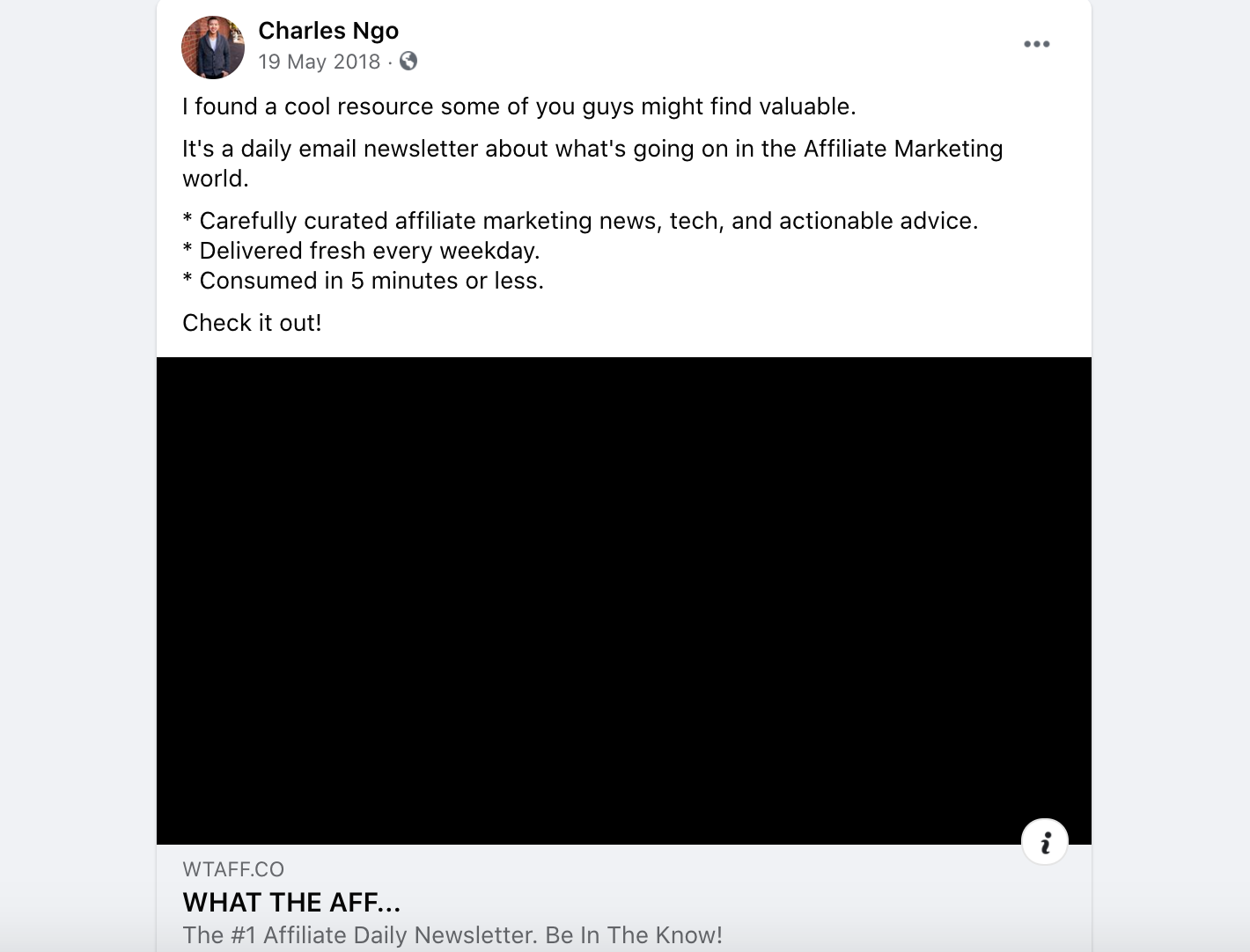
2. Launch to an Existing Audience Via Shoutouts
Look, if you had an existing audience launching a newsletter would be an easy game. The crucial thing is to look at the resources you have instead of what you don’t have…yet.
As in the previous step, use your existing network.
“My Facebook friends – that was the audience,” says Emanuel. “I would say that the audience was bigger than zero but not significant.”
If you don’t have an existing Facebook audience or you don’t want to use it for whatever reason, you can leverage someone else’s audience (which you should do regardless) by arranging shoutouts with your network.
Here’s an example of a shoutout Emanuel arranged on Affiliate Success in the early days (when Stacked Marketer was still called What The Aff:

1. Ask people you’ve built a relationship with. Ideally, you should show them what you’re building first and ask them if they like it (remember, your beta testers). If they do, you’re on the money.
“I don’t think any of those contacts would have given us a shoutout if they thought our newsletter is bad or if some random person asked for it,” says Emanuel.
2. Ask nicely.
At this stage, you should have received some feedback and arranged some shoutouts to start getting some traction. The next step is to leverage paid promotions to really increase your reach.
3. Leverage Paid & Cross-Promotions
“Paid & cross-promotions are definitely a good way to increase your reach in the early days. It will often be hit or miss but the hits should make it worth it,” says Emanuel.
How do you find paid & cross-promotion opportunities that make sense for your audience?
“Whether in dedicated communities, FB groups, or twitter, if you do research into what other newsletters there are out there, you will find your prospects.”
The key here is estimating how well that audience will resonate with your newsletter. There’s no sure-fire way to gauge this but with trial and error you’ll have data that will allow you to make calculated risks.
“You will also learn what sort of other audiences resonate the best with your newsletter, just like we did.”
Here are the key metrics that Stacked Marketer look at for paid promotions:
- Average cost for a unique click for the placement
- Audience relevancy compared to average advertiser; less relevant = higher cost per click, more relevant = lower cost per click.
- Is the expected cost per new subscriber OK given the CPC and our usual conversion rate?
And here are two examples of Stacked Marketer’s most and least successful paid promotion campaigns:
Most successful campaign: A placement on a section of Morning Brew called Brew’s Bets. This landed Stacked Marketer 3K new subscribers at a cost of under $3 per subscriber.
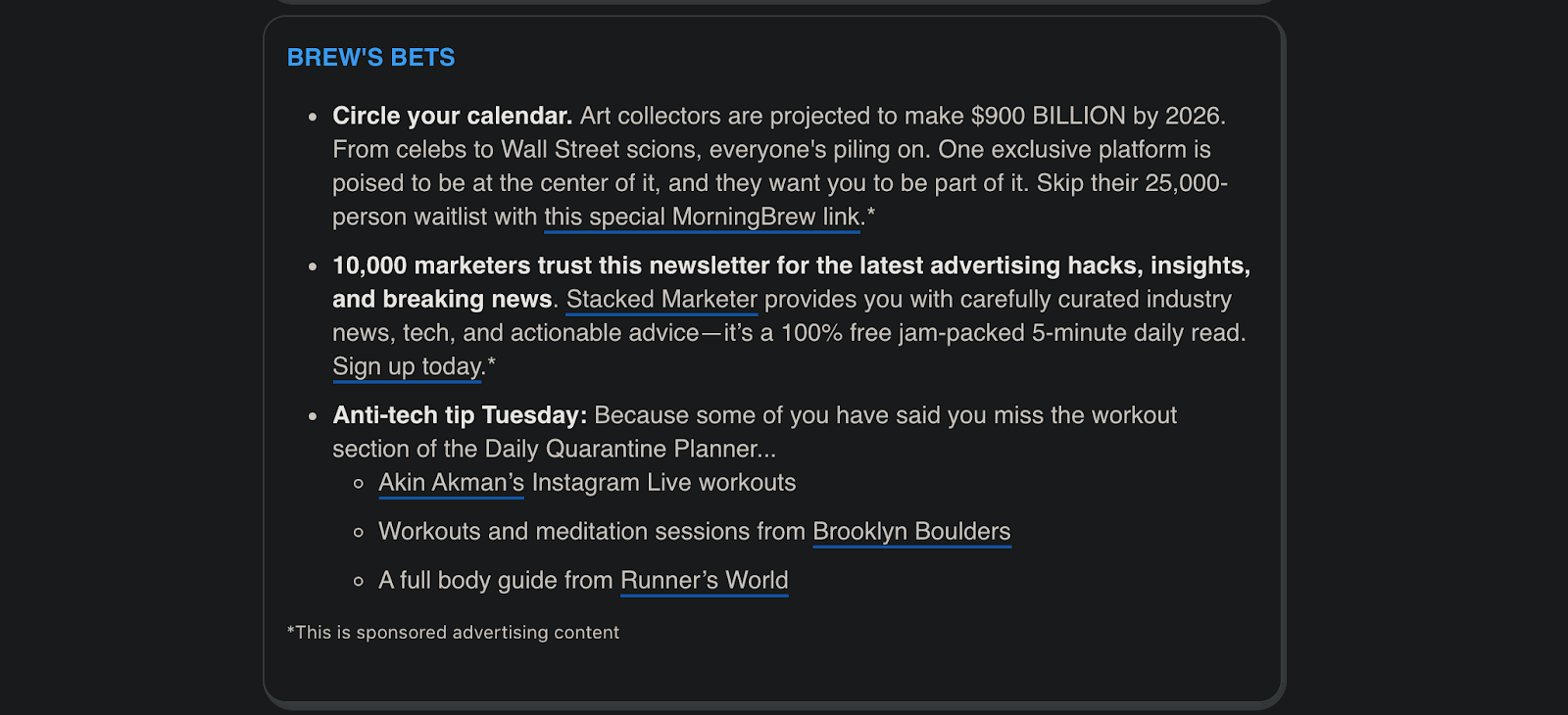
“This placement was available for a cheaper price than usual because it was back in April 2020 when the pandemic just started hitting ad budgets,” says Emanuel.
When it comes to the least successful campaign: A paid promotion with a marketer/digital nomad that generated a whopping 75 new subscribers at $10 per subscriber. 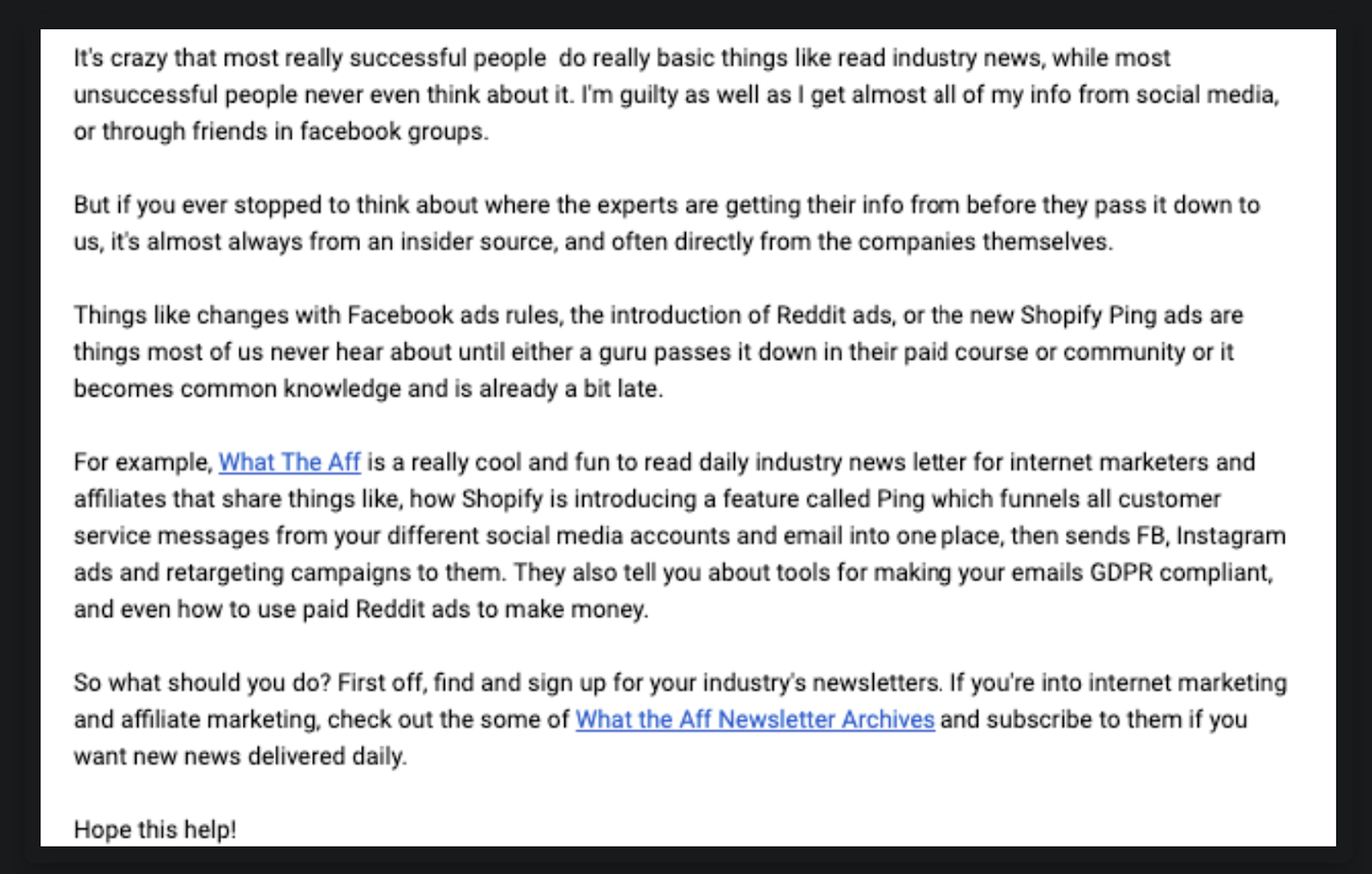
Monetizing Your Email Newsletter
Finally. The section that you’re probably here for. It’s ok. We all like money. I don’t judge. But i’ll tell you this: if monetization is your sole purpose, you probably won’t have enough steam to push through if you don’t see results fast enough.
So many people give up with the treasure chest right below their feet because it’s not aligned with their values and they don’t have the drive to see it through.
Life advice aside, here are Emanuel’s top 5 monetization strategies for beginners.
Sponsorships & Advertisements
Sponsorships and advertisements are a common way to monetize free content and one the strategies that Emanuel emphasizes is the best path to monetization for beginners.
When are you ready to start charging for ad placements in your newsletter?
“It depends on what type of readers you have. If you have two readers but they are Elon Musk and Jeff Bezos, you can certainly already monetize that…we started at about 2k subscribers and 1k unique openers.”
Obviously, you don’t have to take the exact path that Stacked Marketer took. Once you feel like you have a sizable enough audience to drive results for your sponsors, you’re ready to start arranging sponsorship deals.
How do you acquire sponsors and what do you offer them?
For any business, there are two main channels to acquire customers; inbound and outbound. 100% of Stacked Marketer’s sponsors have come through inbound.
Above the fold on the homepage, Stacked Marketer have a CTA to “Advertise With Us.”

Which redirects sponsors interested in advertising to this page:
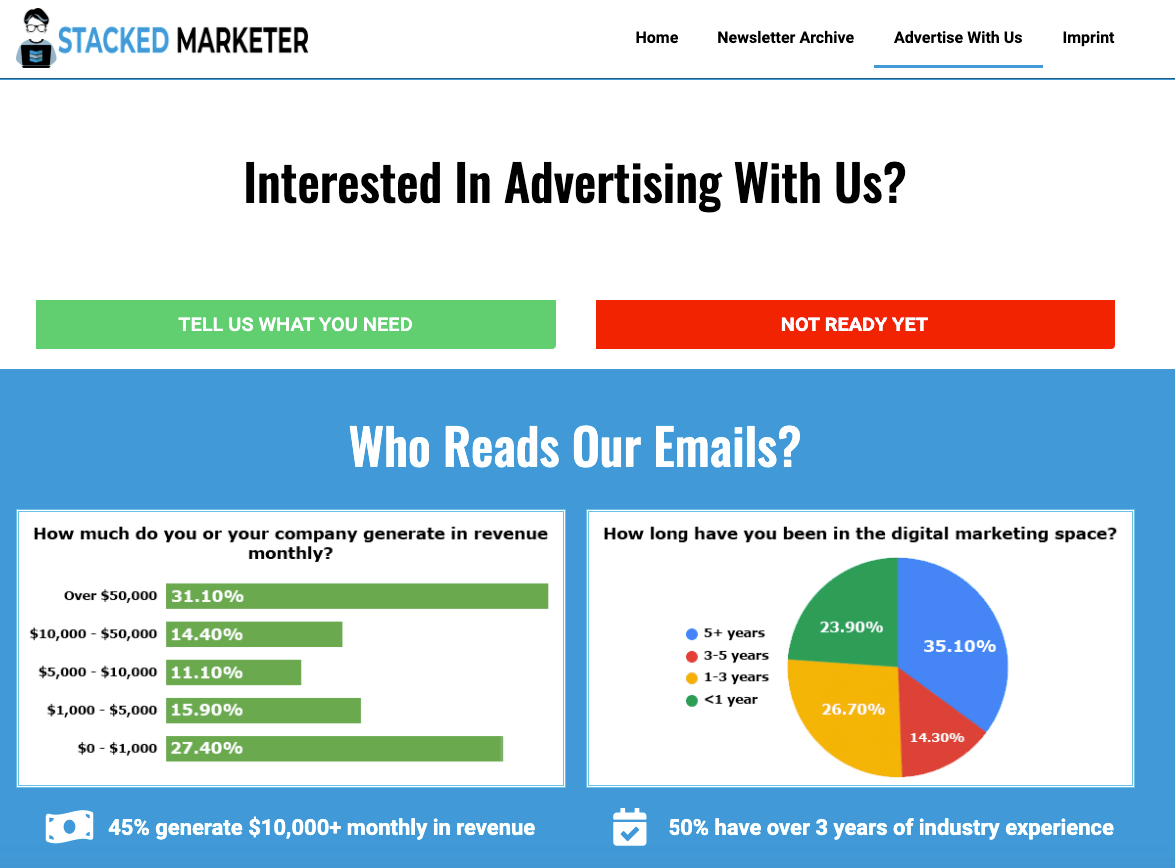
Now, how do you determine how much you should charge for ad placements and what can you offer?
How much you charge highly depends on who your readers are and what other channels advertisers have to reach them.
To come up with initial pricing, do research to see what other similar publications in your niche are charging. Once you have an idea of your initial pricing, you can start testing to see how advertisers respond to it.
If your newsletter is fully booked with placements then your pricing is too cheap and if you don’t have enough placements it’s too expensive. Simple demand and supply. Here’s where you need to engage in a balancing act looking at feedback and performance from sponsors alongside your growth in terms of reach.
Affiliate Deals
“Affiliate deals can work but only a small percentage of them are good so it’s best to focus on other avenues.”
If you’re not sure how affiliate deals work, here’s a quick explanation:
You promote a company's products as an affiliate and receive a commission on each sale that is driven by you. In the case of a newsletter, this would entail linking to a company's sales pages in your newsletter to drive your readers to make a purchase.
Since you only want to promote companies you actually admire/use their products, the best way to find affiliate offers is to check the websites of companies you want to work with and see if they have any affiliate deals.
Once you have a sizable audience that trusts you (or even 1000 true fans), your monetization options start to get more fun, interesting and creative.
Exclusive Communities & Premium Content
An exclusive community is one where membership is paid for. Exclusive communities are a hot commodity because you can easily turn a community into a company.
In fact, companies are buying communities to increase their reach and open up new avenues of monetization (think of Stripe’s recent acquisition of the Indie Hackers community).
Stacked Marketer has an exclusive Facebook community called Stacked Marketer Insiders which provides members with x, y, z.
Paid content can be tricky. You have to provide something people are willing to pay for. The best way to gauge this is to ask.
When you have an idea for content that you think is worth being paid for, ask your readers if they would pay for that specific kind of content. Ideally, you would already have a teaser or first version of the content you want subscribers to pay for.
Other Monetization Strategies
- Courses: Package your expertise into a paid course and upsell your true fans
- Consultations: Provide 1-on-1 consultations for your subscribers/their businesses
- Physical Products: Create a physical product relevant to your newsletters themes
Getting to 16,000 Subscribers and $100K in Revenue
As you grow your newsletter, you want to build a more sustainable and repeatable process for growth. The crucial thing to understand is different growth strategies apply to different stages of your newsletters growth.
Here are two core strategies you should use after you hit about ~2k subscribers.
Paid ads
“When you can afford to do paid ads, exploring FB, Twitter, Google (maybe even Reddit, Quora, Snapchat or Pinterest, depending on your niche) is a must.”
This is where you have the space to scale your reader acquisition with relatively little effort once you figure out the targeting and the ad creatives.
Paid ads won’t be a set and forget strategy, but you should aim at having a system that brings in subscribers regularly that you can still tweak and improve over time.
Referral Program
A referral program helps you acquire new users by incentivizing your subscribers to onboard new readers through tangible rewards.
Here’s an example to simplify that; for every new reader your subscriber onboards, you give them a cake.
Stacked Marketer started a referral program in early 2019 and saw “a great boost;” around 20% of their daily new subscribers.
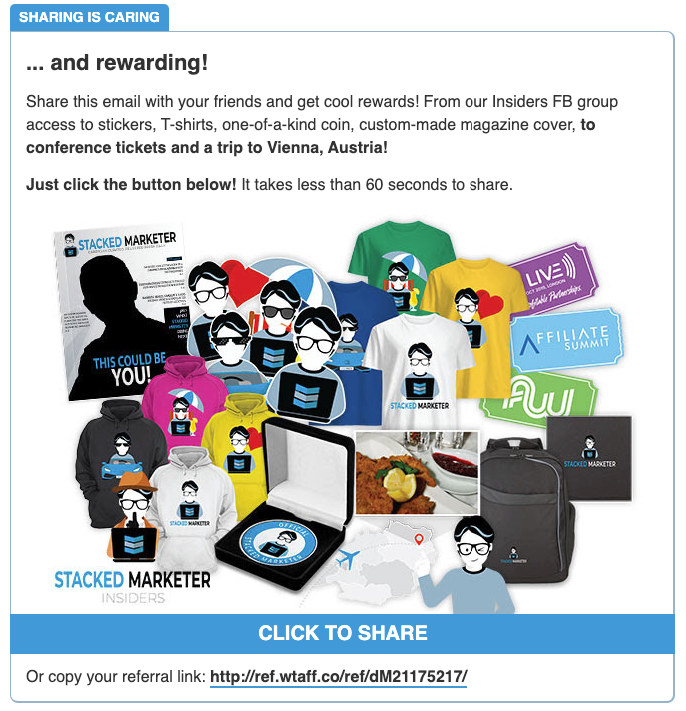
“The key for the referral program are the prizes and the numbers of referrals needed for each prize.”
Stacked Marketer have some creative incentives from membership in their private FB group to custom magazine covers to a trip to Austria.
Ready to Start Your Own Newsletter?
“For now, we’re working on improving our free content.” Emanuel told me about his future plan. And that wraps up this massive case study.
If you ever considered starting your own newsletter, here’s the key takeaways:
- Find your niche. Focus on the intersection between your interests, knowledge and experience
- Clarifying Your UVP. The UVP of a newsletter usually falls under one (or more) of these: convenience, entertainment, and actionable knowledge.
- Choose an ESP. Anticipate how you intend to monetize your newsletter to figure the additional features your ESP needs to have.
- Attract your first 100 subscribers. The best place to start growing your subscribers is your existing network.
- Decide how you want to monetize your newsletter. Some options include sponsorship, affiliate programs, paid content, and more.
- Scale to the moon. Keep delivering what you’ve promised your subscribers and find new ways to grow the list.
Starting a newsletter should be a fun, rewarding passion project. If you approach it with that in mind as opposed to chasing the mighty dolla’ bill — you’ll make the time to start and grow your newsletter slow & steady.
And, you’ll have a blast in the process!
Add A Comment
VIEW THE COMMENTS